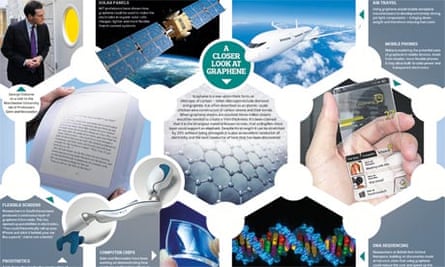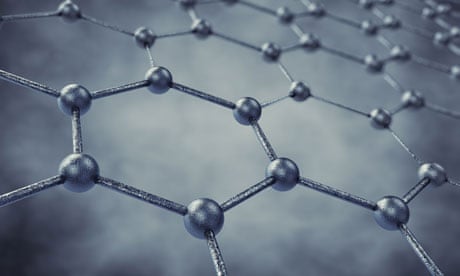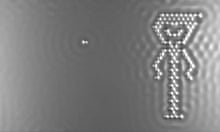Somehow it seems appropriate that the government might be basing some of its hopes for the economy's recovery on a substance that is one atom thick. The substance in question – graphene – 200 times as strong as steel, seems to some designed to carry the weight of almost anything – but George Osborne's Plan A? That would indeed make it a miracle material.
Nevertheless the chancellor made a detour from the Tory conference in Blackpool in September to visit Manchester University, graphene's spiritual home, and to announce a £50m investment. Graphene is claimed by some as an innovation that will prove as revolutionary as the silicon chip, or even plastics, both of which it may supersede. A poster campaign around Manchester currently reminds you that the industrial revolution was born in the city at the beginning of the 19th century. Two hundred years on the challenge is to keep the "graphene revolution" in the north west, too.
Sitting in his lab at the university, Konstantin Novoselov one half of the 2010 physics Nobel prize-winning team that "discovered" graphene, runs through the superlatives of his material – uniquely strong and flexible and the best conductor of electricity yet found – with a kind of amused pride before explaining its genesis. Graphene wasn't so much of a eureka moment as a eureka year or two, but since it was first identified the exclamation marks have kept coming. What they began with, however, was some pencil lead and a roll of Scotch tape.
In 2004 Novoselov, a 37-year old from the Ural mountains with a deadpan wit, was a post-doctorate researcher in conductivity in a department run by fellow Russian émigré Andre Geim. "It was always the style in our lab to have side projects going on," he recalls. "We were working on issues of microscopic electromagnetism during the day, but we had a few after-hours projects on the go mainly for fun."
At the time, Andre Geim was probably best known for his "frog levitation" experiment. This showed that if you placed small amphibians between two large electromagnets they would defy gravity and swim in the air. The experiment won him an Ig-Nobel prize (awarded for the most enjoyably pointless research of the year; Geim remains the only recipient both of an Ig-Nobel and the real thing).
It was in the same spirit of airborne pond-dwellers that Geim and his team began to think about creating a 2D or one atom thick substance. One Friday night, as you do, they were talking about the possibilities of creating a transformer made of metal rather than a semi-conductor such as silicon. The obvious material to test that hypothesis was graphite, so they spent a while trying to find the thinnest possible slice of graphite, to see if it would work.
Over a few weeks they had several attempts at it. On one occasion Geim bought a very expensive chunk of graphite and asked a Chinese research student to polish it on a machine. The student came back the following day with a very expensive bag full of dust.
At around the same time the lab had received a microscope that allowed you to see atomic structures, and Geim's team wanted a very clear structure to look at. Graphite again was the obvious choice and, Novoselov recalls, they discovered that the best way to prepare a smooth surface on the graphite "was to use a piece of Scotch tape and just use it to peel away any residue or dust or crap that was on it".
At some point, thinking again about the metal transistor hypothesis, someone said, "Why don't we have a look at the stuff that is left on the tape", which they were throwing away. "So," Novoselov recalls, "we tested that and the very first sample worked, just about, as a transistor." Over the course of a year, now working mostly full-time, the team improved the conductivity of the graphite by making it thinner and thinner until they got to the point where they could see the ultimate goal was to get something one atom thick, a previously unthinkable goal. "We had worked a lot in micro-electronics but it seemed very unlikely that anything one atom thick could be stable," Novoselov says.

Still using a refinement of the Scotch tape technique, what followed was another "long and quite enjoyable process, testing the properties, making calculations, studying the physics"; and eventually the 2D graphite was produced. Novoselov and Geim were surprised to see that it not only maintained a bonded structure like chicken wire, but also had an apparently uniquely symmetrical arrangement of electrons that enhanced conductivity. Graphene's properties were announced in 2004.
Geim and Novoselov knew they were on to something but were surprised to discover the storm that the discovery made. "We were not aware that there had been a huge community of people already working worldwide on the problem we had solved," Novoselov suggests. "We were just newcomers. But almost immediately papers started to pile up."
Novoselov and Geim, the Crick and Watson of graphene, quickly began to see the possibilities of the material. "It was a new physics for us and for everybody," Novoselov says. There was quickly talk of it creating everything from super-strong aircraft to paper-thin and foldable touch screens, to graphene replacing glass – it is perfectly transparent – and improving plastic, and revolutionising everything from nanosurgery to homebuilding.
None of these possibilities has been overturned by subsequent experiments with graphene but the technology remains so new very few practical applications are in even prototype stage (at one point Novoselov shows me a little square of graphene layered about as thick as cellophane, which switches from opaque to transparent with the application of electricity through a pair of bulldog clips – but that is about as far as it goes).
Graphene may be formed of unique bonds, but the synergy between research and application, between university and industry is still nowhere near as tight as it might be. I imagine, universities and corporations are throwing money at graphene research in other parts of the world?
"Yes," Novoselov says, "but money is not the only thing. Before the £50m we had no more than any other lab, but we still kept at the front of this. It's more time than money." If you think that you can make a new kind of transistor and put it into your computer straight away, he suggests, then you are wrong. How to integrate this into existing technology let alone allow it to begin to shape new technology will take years if not decades. He points to the example of silicon. "The first transistor was maybe 1947, silicon appeared six or seven years later and then it was another 10 or 20 years before integrated circuits." 2D technology may take even longer to become properly commercial, but he has no doubt that eventually it will.
One of the intentions of the £50m investment is to create a "graphene hub" around the Manchester lab, to integrate the research into cutting-edge British industry. Currently the team's findings do not extend too far beyond the university in the north-west. Novoselov and Geim run a regular seminar to discuss issues; it started with just the two of them, but now perhaps 50 people from different scientific disciplines take part, share knowledge and raise questions. The TV astrophysicist Professor Brian Cox, who is based at the university, is alive to the excitement of this group: "Graphene will revolutionise the world, there's not a doubt in my mind," he says. "And this will be the best place in the world to do research into that and commercialise it, if that investment is used properly…"
Exactly how the investment will be used is currently being debated. Novoselov would love in the first instance to open his seminar up to a more commercial audience. "We are going from first principles to prototyping, but if you threw industry people into that room you might get to production quite quickly."
They are, of course, not alone in trying to get graphene to market. To begin with they thought about trying to patent or trademark the material or at least some of their techniques. Geim was disabused of the notion by the CEO of "a world-leading phone company", Novoselov recalls. "Andre was at a conference in the US quite early on. He met this guy and mentioned the idea of intellectual property. He was told, 'We know this material exists and we are doing our own research into it. Of course you can patent it if you want, but if graphene is half the material we think it is we will place 100 patent lawyers on it and you will spend the rest of your life and the GDP of your small island trying to fight for it.'"
Novoselov anyway doubts that protection of knowledge would properly accelerate the technology. To a degree, it has to be open source. If they are going to create a graphene hub, he suggests, then the hub itself needs to be something of a prototype – for the effective sharing of knowledge in a competitive market. It is no secret that European universities do not tend to be as good at such partnerships as American universities and those in the far east; moreover, Britain lacks the commercial scientific expertise in these fields to develop products quickly, compared, say, to Silicon Valley. "We are in the position still where we don't know exactly what they need and they don't know exactly what we have got," Novoselov says. "It is frustrating. We don't want industry to come to us and just say tell us what you know, we want to work in partnership."
The Nobel prize worked quite well as a profile-raiser, Novoselov suggests, but the £50m has worked better: "We have had more contacts from big companies in the last few weeks since that was announced than in all the years before that." Since 2004, he reckons, the lab has spent around £6m on research in total, about half raised from European grants and the rest from projects with South Korean and American corporations. Novoselov hopes the government money will attract more leading-edge scientists to the project, reversing what has been "a bit of a brain drain" to the far east.
Does he feel a weight of responsibility, as a potential saviour of the British economy?
He laughs. "To a degree. Remember that £50m on a global scale is not a vast amount of money. For us it is good money, but the government spends that in a blink of an eye on quantitative easing, or a few miles of a new road or whatever. Still in terms of graphene I am certain we will have something…"
It is that faith which keeps Novoselov working the long hours (though with twin two-year-old daughters at home, sleep is not always easy to come by). And graphene itself is the gift that keeps on giving. Every month, he suggests, there are new possibilities. "The real excitement at the moment is the way we can now layer graphene with different 2D materials," he says, "with each layer having different properties." The stacking means that in theory it will be possible to design materials with the properties to meet any needs. "You tell me 'I want blue and highly conductive and bendy' and we can make it." To a certain degree, he suggests, the only limits to graphene may be those of imagination. "We still tend to think of how this material might be used in the form of current objects. We can imagine, say, a 2D layered photodetective material, with a solar cell and transistor combined which would allow you to make a very thin plastic touchscreen that generated its own power." He smiles.
"We are still thinking inside the box but trying to enlarge the box slightly." The possibility though, he suggests, is that the pencil-lead and Scotch tape miracle will one day create different boxes altogether. Whether they will be made in Britain may yet be the ultimate £50m question.



Comments (…)
Sign in or create your Guardian account to join the discussion